I've been making a few versions of a dress from Tessuti patterns, their Bondi dress. We are doing a class at Hello Stitch in April to sew this dress, and the pattern is included in the class. We also will have one of each size sewn up so you can come into the studio and try on to find your perfect size. More on my other classes below but let's get to Random Threads!
New Pattern Releases: every time there is a new pattern release I tend to think "hmm...not at all interesting" and then a few weeks/months/years later I buy the patterns. Do you jump on the new patterns or let them marinate a while? Even the new Burda magazines, I'm just now finding things I would like to make from the Dec. and Jan. issues and the spring issues are kind of bland. Which means in about 3 months I will find all kinds of stuff to sew in them :) Late breaking edit: I just looked at the Burda May issue preview and line drawings and meh, nothing interesting. Just saw the new Vogue Summer release, and again, not so much. With the exception of Vogue 1584 Tracy Reese knit dress which is all kinds of interesting and I hope to get to that this summer.
How do you Pin? Now that I have lots of students I am fascinated to see how people pin when they are sewing. Generally I can only do it one way, it's not necessarily right or wrong, but based on the fact that I am right-handed, and it seems the sewing machine is set up to favor a particular way.
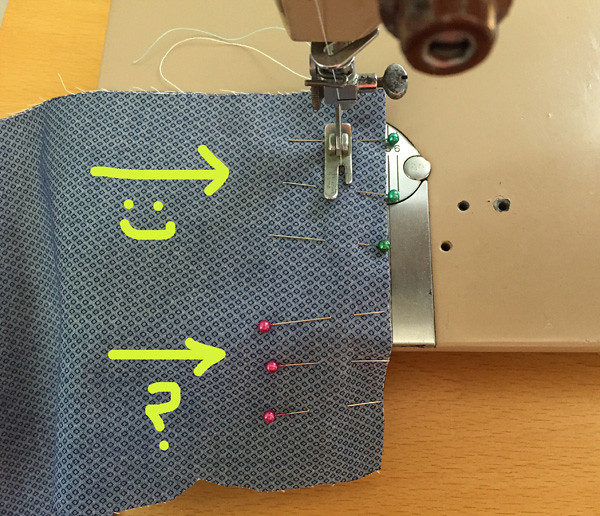
I put the heads of the pins on the edge of the fabric, as this makes it easier to remove them with my right hand and also easier to pin them in. But so many people put them in with the heads of the pins towards the garment. Do you do it a specific way, or have you even thought about it. Note that the photo above is exaggerated - I am always trying to get students to use fewer pins. I think newish garment sewers tend to put too many pins which is cumbersome and probably not needed but it does take some practice to use few or no pins.
Direction and angle of darts: Oh this is my obsession of the week. Bust darts that are completely horizontal just drive me crazy. I think they look so odd. But perhaps this is a question of personal preference and it is not something anyone else notices. We all have our own little obsessions, things that just bug, yours could be collar shape, or pocket placement, and mine is dart position.
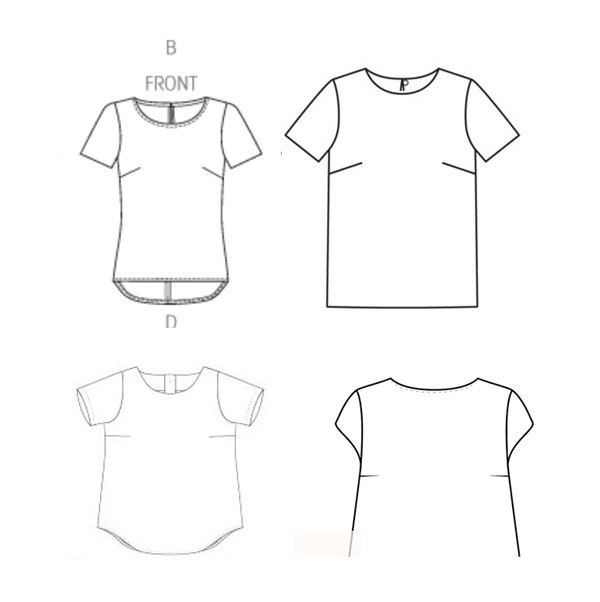
To me the bust darts that are completely horizontal look cartoony. I didn't want to include finished garments as I haven't sewn anything that I could recall with this feature, but here are a few line drawings to illustrate this. Have you noticed this? What is your irrational annoyance in pattern design?
Changing your mind mid-project: I'm in the middle of making a shirt from a recent Burda magazine and about half way through decided that the fabric was all wrong for the style. Or not really so bad but it would be better as something else. Plus our weather is heading towards hot so what was I thinking making a long sleeve shirt?
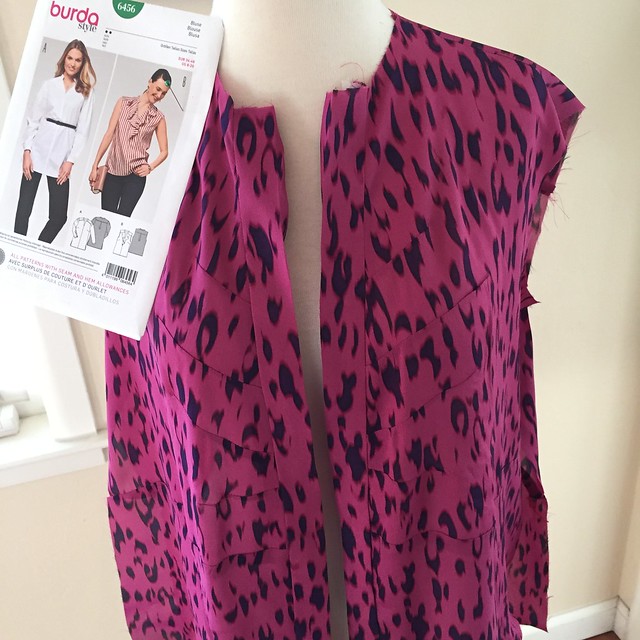
I had been making this shirt from the April issue (see, trying to make something right away does not work out for me :) It's a cute shirt and I will revisit it in the fall. Meanwhile I just bought this envelope pattern, which I'm sure I saw in a magazine in the last year or two. Anyway I had not cut out the sleeves for the shirt, sometimes I do that when sewing, just cut out the pieces that I need to start and wait on the other details like sleeves. Consequently I will use the back as is and then I can eke out the front and ruffle from my remaining fabric. This silk almost-chiffon is more suited to a ruffle top than a darted one.
My new favorite blog: Sea of Teal. Here's a link to a great outfit post. There is something about her style that I find really appealing. And I'm always glad to find a new to me blog with someone making coats or jackets in addition to all the other wardrobe components.
Dark fabrics in the laundry: Are HE (high efficiency) washing machines actually lower in efficiency? I ask because mine is causing all kinds of frustration when I follow all the guidelines and wash dark fabrics, particularly denim.
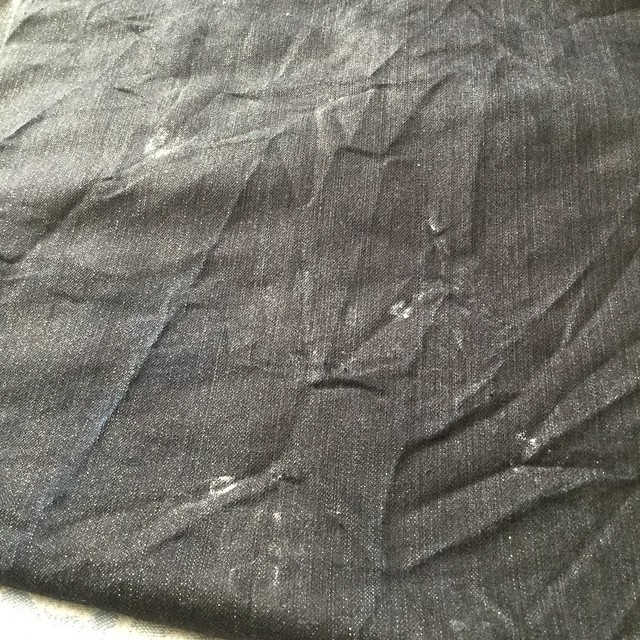
I washed this piece of black denim, which has gold metallic threads, very cool and will be turned into a summer little black dress of the casual variety. But boo hoo, I put it in the wash with other dark garments, used the minimal liquid laundry detergent, set the machine for 2 rinses, and STILL have some white blobs of detergent. I get this all the time with jeans and other dark clothes. I think the high efficiency is somewhat of a joke as it does not rinse properly. SO less water allegedly but sometimes I have to rinse and spin a 2nd time. Any suggestions? I did rinse and spin again and the spots are gone but :(
Custom Dressforms: So often people ask me about sewing and ask the usual questions such as "do you have a super fancy sewing machine" my answer is no (pretty much the opposite.) Do you have to use a dress form? Again my answer is no. It's nice to have but something I sewed for myself without for most of my life. I do have a couple of form now, one adjustable one was a Christmas gift, a couple that I bought at garage sales, and now people have given me a couple. In fact I kind of have too many! But last year Yuliya from Bootstrap Fashion Patterns contacted me and asked me if I would try out her new patterns for sewing a custom sized dress form. I was interested but to my slight embarrassment it has taken me up to now to get it completed.
My verdict is that is amazing! and like anything else in the sewing world, takes a bit of effort, might need some adjusting here or there but on the whole it is a great option if you want a dress form for your figure.
Here's the image from their website and the link to this pattern page.
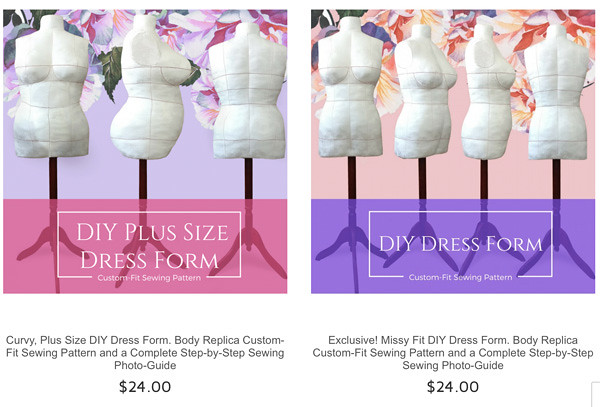
Let's dive into the details. For starters I suggest you look at the Bootstrap Fashion page, and watch the video to see if it's something you would want to do. I have been planning to do this for months, ordered the pattern last year and finally printed it out and sewed it up. I didn't take all that many photos as I was constructing but a few so you can get the idea of the process. So I'm adding those photos here, with some details however I just wrote an extensive review on PatternReview.com so read that for more info. I will put the highlights and some of my advice here but definitely click over to that review as well. I made this using the measurements of someone I sew for regularly and it's pretty close to their shape.
First thing - get a friend to help with the measurements. Some of them are quite specific and it's not really possible to do them on yourself. Here is the input screen, on each measurement there is a little question mark and red asterisk, if you click on that you get the little illustration to show how to measure which is really helpful. I printed out these screens so I could make notes of the measurements and then put them in the order when I had time to concentrate on it.
The info about what fabric to use and the interfacing was invaluable, and I suggest following it. I followed their advice to create my paper pattern pieces, lay them out on fabric to determine just how much was needed. Saved some $ on the amount of fabric and interfacing which was less than I anticipated and then I could buy just what I needed. And also fuse just what was needed.
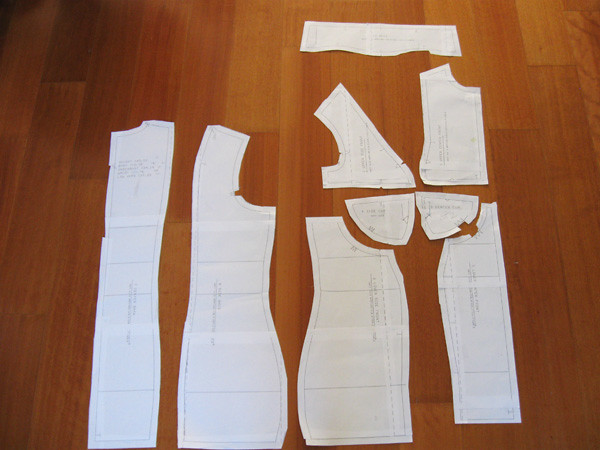
Here are the main body pattern pieces. Not too difficult to assemble, sewing-wise.
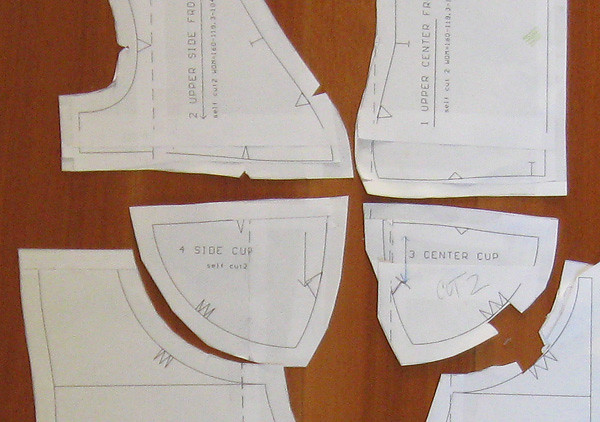
Here's a closer look at the pattern pieces. See all the different shape and size notches. Quite helpful and they matched up perfectly. I added 1/2" seam allowance - not sure why I chose that, probably 3/8" might be even easier to sew.
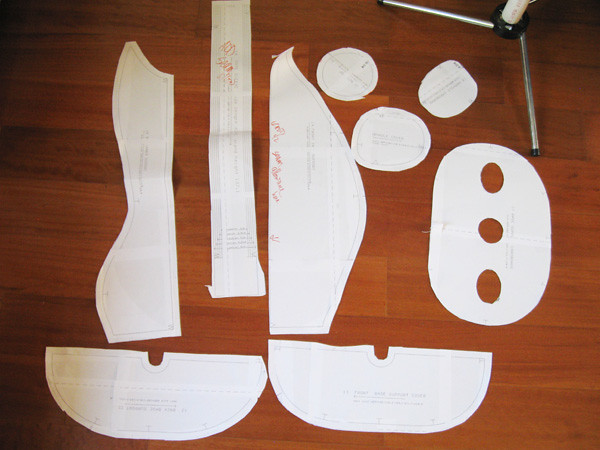
This array above shows the pattern pieces for all the structure and internal support pieces, and the cardboard pieces. They look like kind of an odd shape, but how it goes together is that the body cavity is in half and supported down the center by two very firm pieces of fabric, so actually when you go to stuff it you are stuffing two the separate sides.
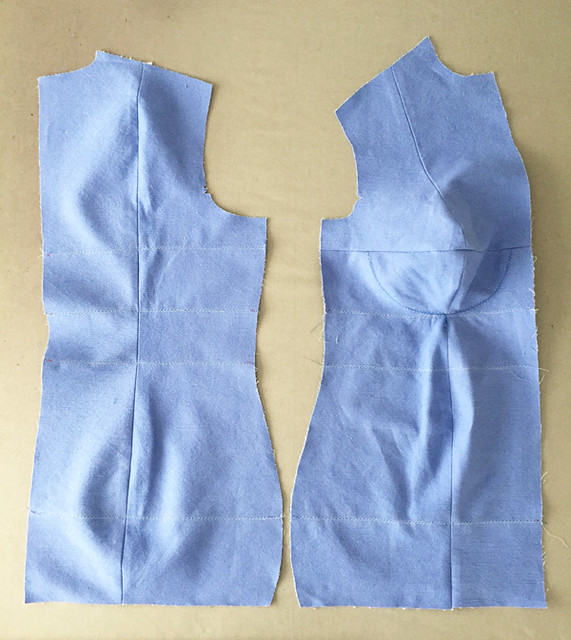
Here is one half of each front and back side by side so you can see how it looks prior to sewing it into a body shape. The horizontal lines are clever, at hip, waist, underbust and bust. I did them in a not too contrasty thread color - and skipped the one that goes across the bust cup, not sure why and I regret that now. I think the zig-zag stitching both gives you the horizontal lines, tames the seam allowances inside somewhat, and stabilizes the fabric in the horizontal direction so you don't over stuff.
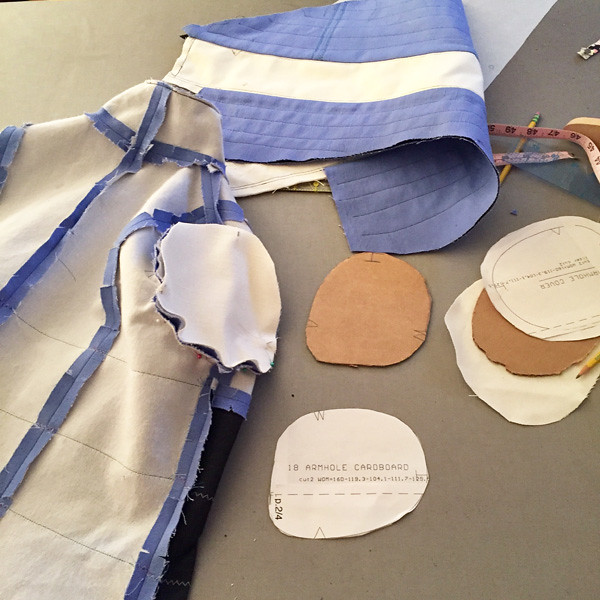
Here's a look at almost finished construction. You create pockets at the armhole where a piece of cardboard is slipped in, to reinforce that area. Clever! The piece at the top with the rows of stitching is the internal vertical support. You can see it has a fabric tube in the center where the PVC pipe goes to hold the thing upright.
This one is a bit sad looking - during the stuffing process it has the look of a deflated balloon when you are part of the way through. Read the details on my review to see what mistakes I made during these stages. But to sum up - you could do it on your own but having a helper is a plus. Stuff it all on one session. Measure as you go (which the video tells you to do) Don't over stuff.
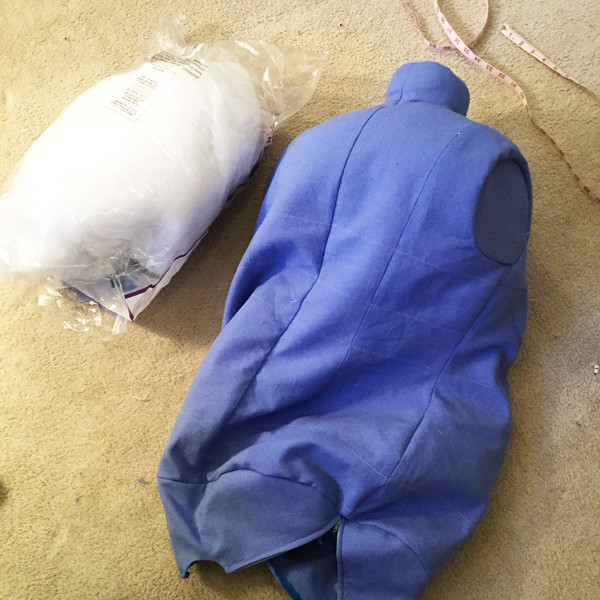
I put a few more photos on the review. You can see my stuffing is a tiny bit lumpy in places. I found that if you work with it, almost knead it a bit like you would with other things you stuff (pillows etc) it smooths out and gets the shape you want.
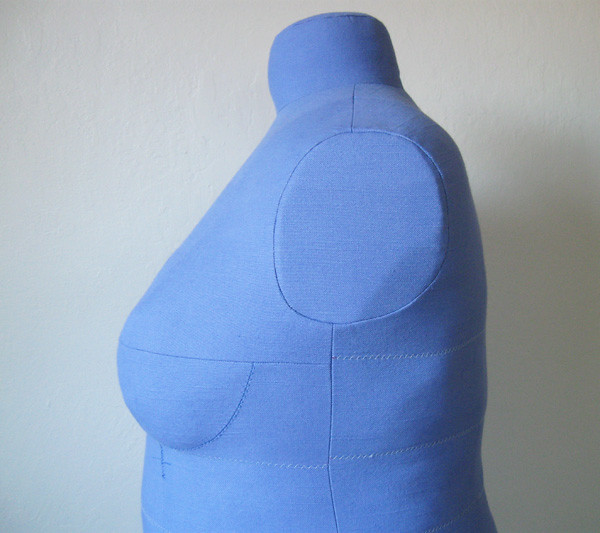
So to summarize a few of my thoughts and observations.
- The instructions are really good. I suggest watching the video, reading through thoroughly and then assembling all your supplies before you start.
- The whole thing takes a good amount of time. I am a really fast sewer (and at cutting out) but between printing the pattern pages, assembling, adding seam allowances, fusing interfacing, then cutting out, marking precisely, and then stitching up it is a good bit of time. Maybe 10-15 hours? This portion of the whole project can be done in lots of small increments as your time permits.
- Stuffing - have a LOT of the stuffing available. Buy more than you need and return if too much. Have someone help you - it gets a bit awkward to wrangle as it gets more stuffed. Do the stuffing in one session and close 'er up 😅. Measure the circumference at hip. waist, bust etc which helps you get it stuffed correctly.
- Cost: the pattern is about $ 25. Supplies include the PVC pipe, glue, sponge, fabric, fusible interfacing... stuffing, Lots of Stuffing! I think I spent about $ 70. So the total is closing in on $ 100. I was able to put the form on the base of an old broken form. I read an idea about taking an old desk chair, removing the chair part and using the wheeled base - clever! Having wheels on a dress form is the best. I have one with wheels and it so handy. Measure carefully the base, pipe diameter etc. All that info in included in the instructions.
- Fit: the pattern pieces did sew up to the correct measurements that I input. I especially like how the shoulders, neckline etc are the correct size, i.e. a body double. The shape of the bust is a bit generic but that was to be expected. I think I might input measurements that are slightly smaller than the actual body I was trying to do, and then have some wiggle room to pad out in places as needed.
I hope this helps any of you who are interested in doing this. While it was a good amount of work it has a nice result. I'm generally not a person who does fitting on the dress form which a lot of people seem to think is the answer to everything (prefer to do by measuring the pattern) but having a dress form is nice, helps visualize things, get proportions right, is great for placing items on during construction. And if you can use it for fitting then that is a bonus.
Up next - I am thinking spring although I have plenty of end of winter items still to blog. I posted a few peeks at my McCalls 7549 jacket so that might be next here.
Classes I'm teaching in the upcoming months at Hello Stitch Studio in Berkeley are a mix of one's we offered before such as Garment Copy, Pattern Reading, and Knit T-shirt, plus some new ones which are Pencil Skirt class and a Pants fit clinic. And next weekend's Jacket class has spots open so if you want to see me construct a jacket and see demos of all kinds of tips and tricks for fast tailoring please join us.
Edit for Sat. April 7: thanks for all the info on the HE washing machine, I will try using a very small amount of detergent.
And what? few comments on the custom dress form - that's what I thought would be the item of interest on this Random Threads 😄.
Edit for Sat. April 7: thanks for all the info on the HE washing machine, I will try using a very small amount of detergent.
And what? few comments on the custom dress form - that's what I thought would be the item of interest on this Random Threads 😄.
Happy Spring Sewing,
Beth
Today's garden photo - it's tulip time!!
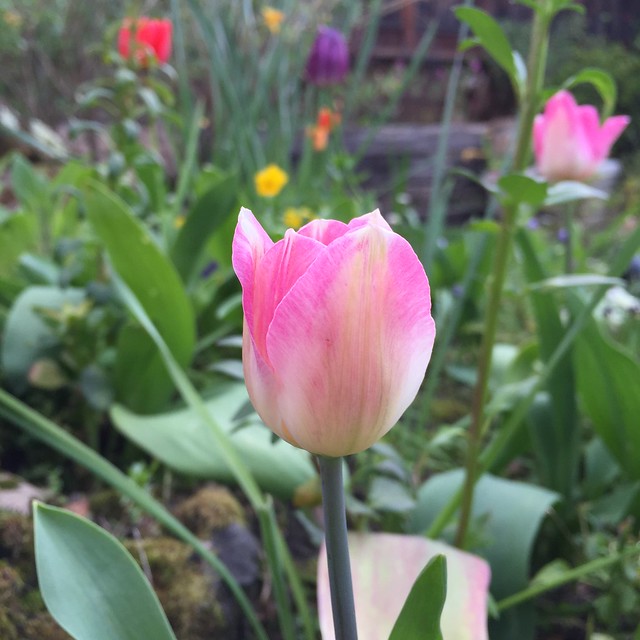

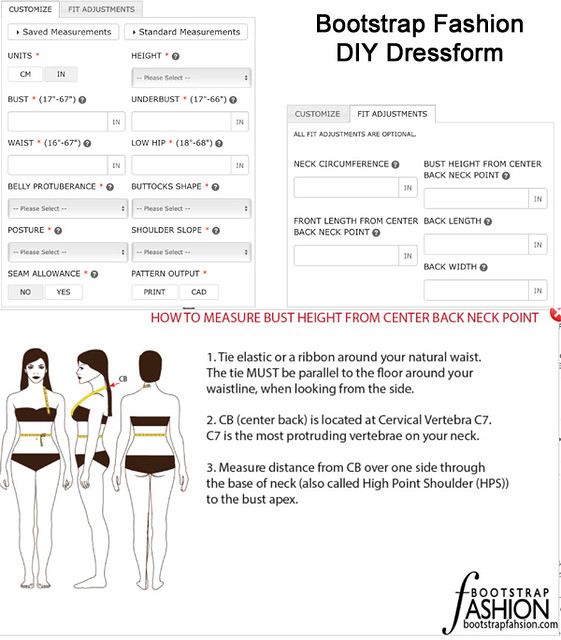










1) pins: I'm rt handed so pin with head out.
ReplyDelete2) bust darts: look goofy 😋straight across
3) laundry detergent spotting:
If you use powder switch to liquid - other wise no clue - I don't have HE machine
4) made to measure body double how cool is that! Although I think for me it'd be an incentive to loose weight lol
then it would be usesless.
I think I'll just stick to old school & fit to myself.
Pretty tulip!
Becca G
I was taught to pin with the head facing out in order to remove the pins while sewing at the machine. For pinning that will be followed by basting, sometimes I pin at an angle or parallel to the sewing line.
ReplyDeleteThanks for the information about the Bootstrap form pattern. I've wondered about that. I'm fortunate to have a used professional form that is padded, but online I see so many methods that appear to be a waste of time. If I had to make something for someone it would be nice to have a form with her measurements.
ReplyDeleteMy HE machine (you can't buy anything else today) does the same as yours. Powder or liquid, makes no difference. Set for warmer water, 2 rinses. Not anything you're doing wrong, I think.
ReplyDeleteI loathe my new washing machine. It does the same thing as yours. When I rang up the repair centre, they told me all new washing machines are designed to be water efficient, which really just means they use the minimum of water (not really enough to cover clothes) and beat your load around more to clean it. Hence the washing powder and debris is not properly washed away, and the manufacturer can claim more stars for a higher water efficiency rating.
ReplyDeleteThe repair person suggested (as she does to everyone with these new machines, apparently) manually adjusting the wash so the tub was filled with water, so the load would actually be washed and rinsed adequately. It does work for the most part, but it seems to negate any claims to water efficiency. We still have to wash dark or fluffy clothing separately, which is something we never did with our trusty old machine.
I also have a HE machine, but I have never had results like that, though I wear and sew with a lot of black and indigo. I do all my washes on cold water, one rinse. The only thing I do differently than most is that I use about half or less the amount of detergent as is recommended. I read somewhere that what really gets the clothing clean is the repeated sloshing of water through the clothes, and all the detergent is for is to keep the dirt from being re-deposited, and that the "recommended" amount is much higher than is actually needed. You might give a try to using less?
ReplyDeleteUse no more than 1 tablespoon of detergent and NEVER pods (left plastic and spots in my clothes--they do not dissolve in HE machines). I sometimes have to rinse a 2nd time but much less now that I reduced the amount of detergent.
ReplyDeleteI have had a HE washer since I moved into my house 14-15 years ago. I use much, much less detergent than recommended. (And my clothes are clean!).
ReplyDeleteThanks for a very interesting read this morning. Impressive mannequin!
ReplyDeleteIt makes sense to have the pins sticking out so that it doesn't matter which way you sew the pins are always visible. I often sew a sleeve in flat and find I've pinned it a different way to how I actually sew it at the machine so pins out means I can still see them clearly.
ReplyDeletePeggy Sagers says she always washes her denim in Coca- cola along with water. You can check it out on her web page.
ReplyDeleteI used to have the same problem with my HE washer. Problem solved when I found the setting that didn't use the minimum amount of water....on mine it is cold water clean. I can use any of the other choices with max water just by choosing My Cycle along with those choices. Hope this helps.
ReplyDeleteLike you I consider myself an experienced and professional sewist and have never purchased a fancy, dancy sewing machine or dress form. When sewing for clients I make muslins to get the perfect fit and a dress form would not work. I am, however, intrigued with your info on Bootstrap. I always enjoy your posts. Karen
ReplyDeleteSo HE machines, I have one and would switch in a minute if I had the money. Spots- after digging endlessly about this on the internet - HE machines need to have the cleaning cycle done once a month. That seems to help, along with when I do bulky fabrics ie: jeans I do a second rinse. But I have also found this just seems to happen to some fabrics ie: microfiber. I love your blog. Good luck with the machine.
ReplyDeleteWe live in an apartment building and the laundry room went HE and my husband noticed the towels were full of soap which was really annoying. He had to give them another thorough rinse in the tubs and of course then they were sopping wet that the "energy efficient" dryers couldn't handle! We complained and they changed the settings so they'll work like "normal" machines (I have no idea how they did this). And all this when we use liquid detergent (very little of it too!) and always rinse with a cup of vinegar! I use as few pins as possible and actually prefer the clips which I use all the time...I have a dress form that I customized with a package of foam I ordered separately and use it but I wouldn't say it's better than trying the garment on your own body. It's okay for an "idea" of what it will look/fit like but it's just an estimation really.
ReplyDeleteI used to have those laundry problems too with my water efficient washer. I started using the liquid detergent from Trader Joe's and only using the amount recommended on the bottle, which is way less than what the washer indicates. Haven't had a problem since!
ReplyDeleteThanks for sharing the dress form! That seems like a wonderful solution and it looks great.
This looks like the best way I’ve seen yet to do a dress form. Perhaps this is a possible new class topic? I think I’d take it.
ReplyDeleteHad a dress form made for me as a big 50 birthday present. Now, at 62, weight has shifted!
Thanks for the great review of the dressform - I'm going to give it a go!
ReplyDeleteOn the HE washer: Make sure your detergent is labeled HE. Also, on my machine filling the dispenser takes WAY more detergent than using the cap and filling it to the minimum line. I've found that I have to wash more, smaller loads but I've never had a problem with spotting.
ReplyDeleteFor the dress form, I'd like to use the Bootstrap pattern but mount it over the top of an old dress form. What happens if I leave the support stuff out in the middle? Harder to shape?
Thank you so much, Beth, for including me in here and your kind words about my blog! I'm happy you like my makes and my style. I just came back from holidays just to discover you featured me!
ReplyDeleteHave a great Sunday and greetings from Germany!
Sincerely,
Stef
Re: pins: I attended a 3 day seminar with Kenneth D. King last summer and he said he pins vertically, which I have never seen before, an pulls the pins out as he goes. I guess if you don't think sewing over pins is a good idea, this is one way to make sure you don't do it! I find it awkward though, probably just because I'm not used to it.
ReplyDeleteI also have an HE washer, and I must say I've never had the problem you mentioned. We use liquid soap and generally less than would normally be used because we have soft water which makes it possible to use less soap.
The key for HE washer is putting less clothes in them. On average people overload their machines. You would be surprised to see how little you should be putting in there. How do I know? I work in the industry. I see it all. The water will never be sufficient in rinse cycles on new water saving machines. I have a front loader and use a minimum amount of soap, never had the problem of spotting. There are machines out there that allows you to control the water level.
ReplyDeleteThanks for the dress form demonstration. I had wondered about those. I put my pins in from the right. I love my HE washer. I second the woman who uses vinegar. I use it in the fabric softener compartment when I was towels. Cuts down on stiff washcloths. Never had a problem with white spots. Also wash many items inside-out and always close the zippers.
ReplyDeleteThat dress form design is genius!
ReplyDeleteIt's a very informative post! Thank you for sharing, Beth!
ReplyDeleteI hated our HE washer and am glad to be back to a traditional. That used to happen to me too, especially with laundry pods.
ReplyDeleteHorizontal darts look weird.
I love that Tracy Reese dress.
Wow lots of great info & inspiration! I’m a lefty so my pin heads face the garment so I can get them out easily .
ReplyDeleteThis looks very interesting . Another good base fro this form is an old fan base . Works really well.
ReplyDeleteAnother great random threads. I really like that Vogue 1584, it looks lovely!
ReplyDeleteI'm left handed, so I pin the other side around. Actually it's funny because I never thought of this before!!
I completely agree with you about horizontal bust darts. In general, bust dart placements, angle, point etc. are a major pet peeve. I cannot wear a garment on which I think the bust dart looks strange.
Sea of Teal is great, she's one of the first sewing instagram account I ever followed.
Thank you so much for your detailed review of the Bootstrap form, I always find these processes fascinating. I have a custom form made to my measure in New York, but if my measurements change significantly I will definitely consider making this!!